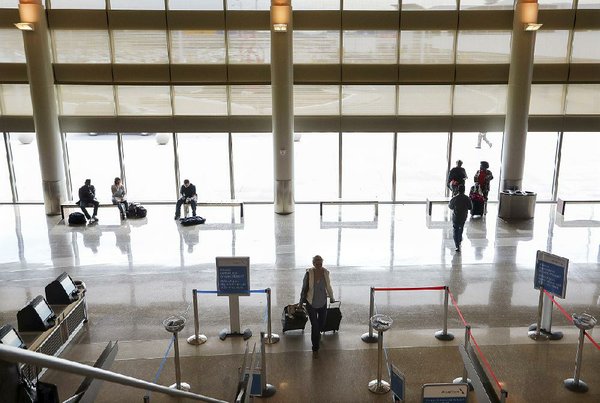
Executives at Bill and Hillary Clinton National Airport/Adams Field have proposed a $34.4 million operating budget for 2022 as air traffic is expected to continue improving next year but likely not reach levels enjoyed before the covid-19 pandemic.
The proposed budget is 41% higher than the $24.4 million budget in 2020, when air travel was sharply curtailed for much of the year, and 8.7% more than the estimated operating budget for this year when passengers began returning to the skies in earnest.
But it still remains 6.9% smaller than the $36.9 million operating budget the airport enjoyed in 2019, the last full year before the pandemic swept the globe.
"The COVID-19 pandemic greatly affected all areas of our lives in 2020, including air travel," the airport staff said in budget documents submitted to the Little Rock Municipal Airport Commission. "While the impact of the virus subsided in 2021, the effects are expected to continue into 2022. This impact is reflected in the 2022 budget."
The proposed budget also anticipates $26,999,563 in expenses. That sum stands in contrast to the anticipated $22,871,927 in expenses for 2021. The $4.1 million difference marks a 18% increase year over year. The difference between what was budgeted in both years yielded a $1.5 million difference, or 5.9% increase.
Although two members of the commission's finance committee -- vice chairman and treasurer Jill Floyd and Bill Walker -- recommended approval of the proposed budget, both expressed concern about the sharp rise in expenses and asked staff to project out expenses for the next several years to see whether they would be on a sustainable path. The third committee member, chairman John Rutledge, was absent.
Almost half of the $4.1 million increase in expenses, or 46%, is attributed to increases in labor costs.
Salaries and wages in 2022 are budgeted at $9.5 million versus an estimated $8.3 million in actual salaries and wages this year. The difference includes adding three positions for a total of 176, filling several positions that were left vacant during the pandemic to keep down expenses, merit pay increases and an increase in minimum starting pay.
Employee benefits are correspondingly higher in next year's proposed budget. They rise from an estimated $4.1 million in 2021 to $4.87 million next year.
Bryan Malinowski, attributed other increased expenses to increase in software licensing fees, increases in maintenance agreements for jet bridges and other equipment whose warranties are expiring, and hiring some contractors to supplement regular staff.
Custodial staff, for instance, have been difficult to recruit, Malinowski said. New art embedded in the floor near the concourse will require special cleaning during overnight hours twice a year. A contractor performing that work will avoid straining the custodial staff, he said.
With the rise in expenses, the airport expects to pocket less in revenue after expenses next year. The proposed 2022 budget will leave the airport with $7.3 million in revenue after expenses, compared to the $8.7 million it expects to have in that category this year.
The proposed budget anticipates no increase in parking fees, the single largest source of revenue for the airport. Of the $31.6 million in estimated year-end total operating revenues for the airport for 2021, $7.3 million, or 23.1%, came from parking revenue, according to the budget documents. Parking is expected to bring in $8.6 million next year.
The document also proposes to keep rates for landing fees and other costs for airlines flat for 2022. Still, increases in passenger traffic will allow Clinton National to see more revenue from landing fees next year -- $5.3 million versus an estimated $5.1 million this year, a 2.8% increase.
Passenger traffic is the main driver of the operating budget. More passengers equate to more flights, more landing fees charged to airlines, more parking lot use, more vehicles rented and more food and beverages consumed, all of which earn revenue for the airport.
Clinton National also receives $4.50 from every passenger who boards a flight from the airport, part of its annual allotment of non-operating revenue. The charge is a federally mandated passenger facility charge that helps pay for airport improvements that enhance safety, security or capacity.
Clinton National, although a city agency, draws no money from the city's general budget and instead relies solely on its operating revenue as well as millions of dollars in non-operating revenue such as Federal Aviation Administration aid generated by the Airport Improvement Program.
Through Sept. 30, Clinton National saw 599,692 passenger boardings, a 67% jump compared to the 359,761 boardings the airport saw in the same period in 2020, according to budget documents.
Clinton National executives said they anticipate the airport will finish 2021 with 842,427 passengers , 72% higher than the 490,544 reported for all of last year.
Again, however, the 2021 estimate likely will fall 28% below the 1,124,672 passengers who boarded flights in 2019.
The proposed 2022 operating budget assumes that 991,953 passengers will board at Clinton National next year. That figure is 11% lower than 2019 totals.
"continued" - Google News
November 15, 2021 at 05:16PM
https://ift.tt/3HA6ZtJ
2022 Clinton National Airport budget anticipates continued growth in air travel passengers - Arkansas Online
"continued" - Google News
https://ift.tt/2WiTaZN
https://ift.tt/2YquBwx
Bagikan Berita Ini














0 Response to "2022 Clinton National Airport budget anticipates continued growth in air travel passengers - Arkansas Online"
Post a Comment